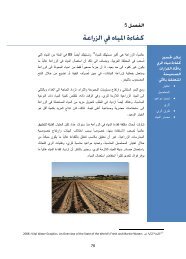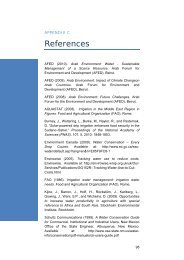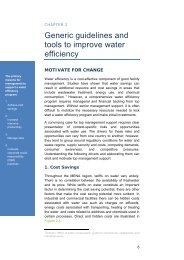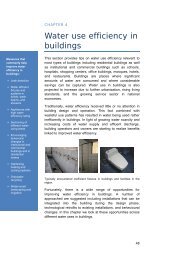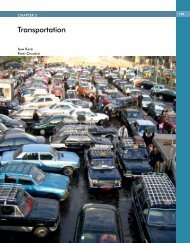Impact of Climate Change on Arab Countries - (IPCC) - Working ...
Impact of Climate Change on Arab Countries - (IPCC) - Working ...
Impact of Climate Change on Arab Countries - (IPCC) - Working ...
You also want an ePaper? Increase the reach of your titles
YUMPU automatically turns print PDFs into web optimized ePapers that Google loves.
134<br />
CHAPTER 11<br />
INTERNATIONAL NEGOTIATIONS FOR A POST-KYOTO REGIME<br />
tati<strong>on</strong> <str<strong>on</strong>g>of</str<strong>on</strong>g> the Protocol will reduce developed<br />
country emissi<strong>on</strong>s by <strong>on</strong>ly 3%, and global emissi<strong>on</strong>s<br />
by less than 2%.<br />
To reduce the burden <str<strong>on</strong>g>of</str<strong>on</strong>g> compliance <strong>on</strong> developed<br />
countries, the Kyoto Protocol created three<br />
different ‘flexibility mechanisms’: a project-based<br />
mechanism within developed (‘Annex 1’) countries,<br />
also known as Joint Implementati<strong>on</strong> (JI); a<br />
project-based mechanism involving developing<br />
countries - the Clean Development Mechanism<br />
(CDM); and internati<strong>on</strong>al emissi<strong>on</strong>s trading<br />
am<strong>on</strong>gst Annex I countries. The European<br />
Uni<strong>on</strong> started an Emissi<strong>on</strong>s Trading Scheme<br />
even before the Protocol was ratified to gain<br />
experience with carb<strong>on</strong> trading.<br />
VI. MARKET-BASED MECHANISMS<br />
Market-based mechanisms are generally favoured<br />
by ec<strong>on</strong>omists and welcomed by industry, as they<br />
tend to reduce the costs to industry (or countries)<br />
<str<strong>on</strong>g>of</str<strong>on</strong>g> complying with targets. However, effective<br />
trading approaches require an overall cap <strong>on</strong><br />
emissi<strong>on</strong>s. Analysts are discovering that the<br />
administrative difficulties <str<strong>on</strong>g>of</str<strong>on</strong>g> implementati<strong>on</strong> and<br />
enforcement <str<strong>on</strong>g>of</str<strong>on</strong>g> cap-and-trade systems am<strong>on</strong>gst<br />
countries are not trivial. There have been published<br />
accounts <str<strong>on</strong>g>of</str<strong>on</strong>g> the weaknesses in the carb<strong>on</strong><br />
<str<strong>on</strong>g>of</str<strong>on</strong>g>fsets market with buyers paying either for<br />
reducti<strong>on</strong>s that do not take place or for reducti<strong>on</strong>s<br />
that would have taken place anyway. Partly<br />
for these reas<strong>on</strong>s, some ec<strong>on</strong>omists prefer the<br />
levying <str<strong>on</strong>g>of</str<strong>on</strong>g> taxes <strong>on</strong> activities that lead to the emissi<strong>on</strong>s<br />
<str<strong>on</strong>g>of</str<strong>on</strong>g> greenhouse gases.<br />
Carb<strong>on</strong> taxes are easier to implement than capand-trade<br />
schemes, ec<strong>on</strong>omically efficient, but<br />
politically difficult to legislate in some democratic<br />
regimes. A carb<strong>on</strong> tax would reduce carb<strong>on</strong><br />
emissi<strong>on</strong>s and increase revenues. Substantial<br />
benefits could be gained from carb<strong>on</strong> taxes in all<br />
countries based <strong>on</strong> the ‘comm<strong>on</strong> but differentiated’<br />
principle. In additi<strong>on</strong> to emissi<strong>on</strong>s reducti<strong>on</strong>s,<br />
they would generate resources for the<br />
development <str<strong>on</strong>g>of</str<strong>on</strong>g> clean energy sources as well as for<br />
the cost <str<strong>on</strong>g>of</str<strong>on</strong>g> adaptati<strong>on</strong> in poor developing countries.<br />
The CDM was created to support low-carb<strong>on</strong><br />
investment in developing countries. It allows<br />
both the private sector and governments to invest<br />
in projects that reduce emissi<strong>on</strong>s (as compared to<br />
emissi<strong>on</strong>s that would occur in a baseline scenario)<br />
in developing countries, and provides <strong>on</strong>e<br />
way to support links between different regi<strong>on</strong>al<br />
emissi<strong>on</strong>s trading schemes. However, it has<br />
encountered administrative and technical hurdles,<br />
and its future is clouded because <str<strong>on</strong>g>of</str<strong>on</strong>g> the<br />
uncertainty about the post-2012 regime. Initial<br />
CDM projects have been limited to a few countries,<br />
and a few gases, and have been plagued by<br />
bureaucratic procedures, with little c<strong>on</strong>tributi<strong>on</strong><br />
to sustainable development.<br />
With its limited targets, timeframe, and participati<strong>on</strong>,<br />
the Kyoto Protocol was never seen as a<br />
final soluti<strong>on</strong> to the climate problem. It was<br />
meant to be a first step, preparing for the broader<br />
engagement that will be necessary and establishing<br />
the legal, technical and instituti<strong>on</strong>al<br />
groundwork for future regimes, especially in<br />
internati<strong>on</strong>al emissi<strong>on</strong>s trading.<br />
Time and experience, however, have also revealed<br />
the limitati<strong>on</strong>s in the agreement - coverage <str<strong>on</strong>g>of</str<strong>on</strong>g><br />
some but not all <str<strong>on</strong>g>of</str<strong>on</strong>g> the developed world’s emissi<strong>on</strong>s,<br />
and inadequate provisi<strong>on</strong>s for m<strong>on</strong>itoring<br />
and enforcement.<br />
VII. LAGGING NEGOTIATIONS<br />
Because the Kyoto Protocol covered <strong>on</strong>ly the<br />
period from 2008 to 2012, it specified that negotiati<strong>on</strong>s<br />
for a sec<strong>on</strong>d “commitment period”<br />
should begin seven years in advance - i.e., in<br />
2005. However, the progress to date has been<br />
minimal. For example, the discussi<strong>on</strong>s at the<br />
Sec<strong>on</strong>d Ministerial Meeting <str<strong>on</strong>g>of</str<strong>on</strong>g> the Gleneagles<br />
Dialogue <strong>on</strong> <str<strong>on</strong>g>Climate</str<strong>on</strong>g> <str<strong>on</strong>g>Change</str<strong>on</strong>g> in M<strong>on</strong>terrey,<br />
Mexico, in October 2006 pointed to the urgency<br />
<str<strong>on</strong>g>of</str<strong>on</strong>g> early acti<strong>on</strong> but failed to decide <strong>on</strong> a process<br />
for reaching a new agreement. Likewise, at the<br />
November 2006 C<strong>on</strong>ference <str<strong>on</strong>g>of</str<strong>on</strong>g> the Parties to the<br />
UNFCCC in Nairobi, governments were unable<br />
to agree <strong>on</strong> a timetable for negotiating a post-<br />
2012 future despite widespread c<strong>on</strong>sensus <strong>on</strong> the<br />
diagnosis <str<strong>on</strong>g>of</str<strong>on</strong>g> the problem. This lack <str<strong>on</strong>g>of</str<strong>on</strong>g> progress<br />
increases the risk <str<strong>on</strong>g>of</str<strong>on</strong>g> failure in reaching an agreement<br />
to govern the post-2012 period. Those<br />
who have witnessed the glacial pace <str<strong>on</strong>g>of</str<strong>on</strong>g> these<br />
negotiati<strong>on</strong>s (and the North-South divide that<br />
appears to be widening) have identified several<br />
factors that may be c<strong>on</strong>tributing to this impasse.



